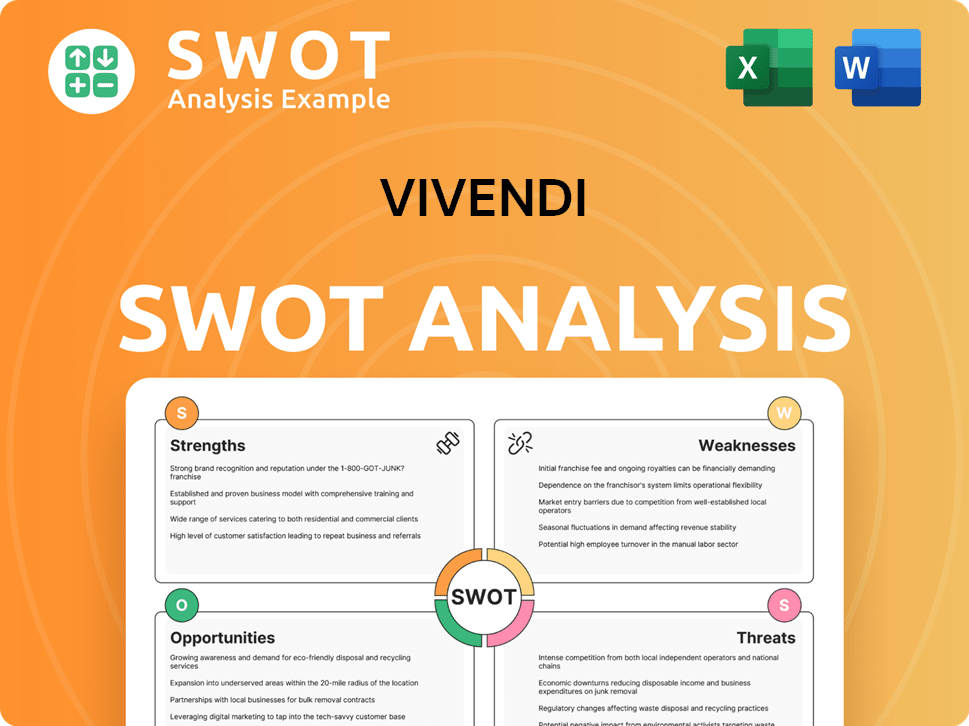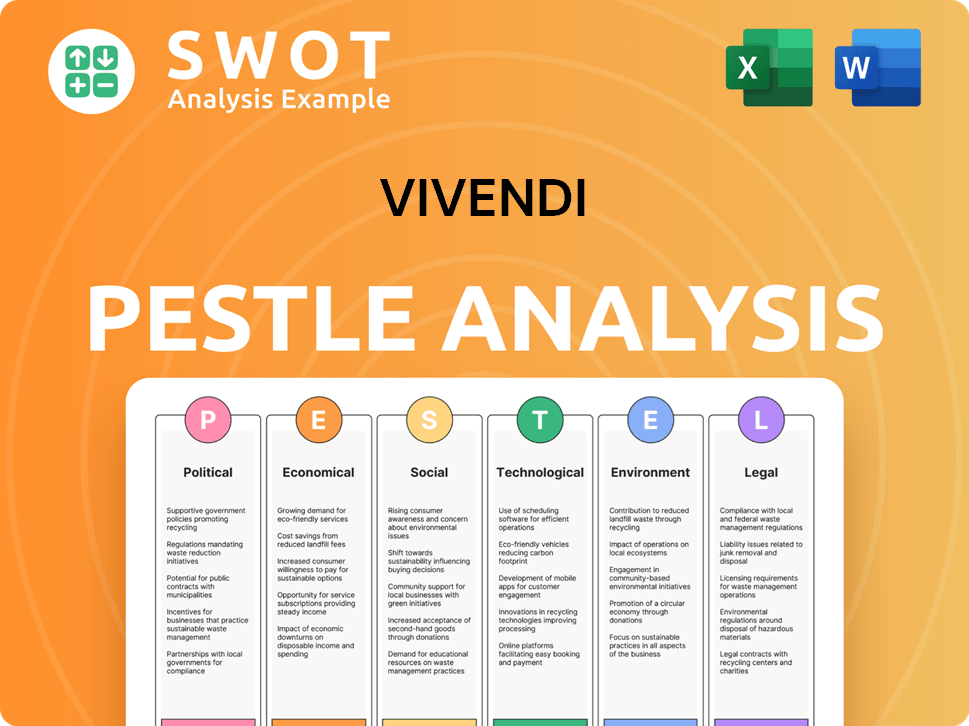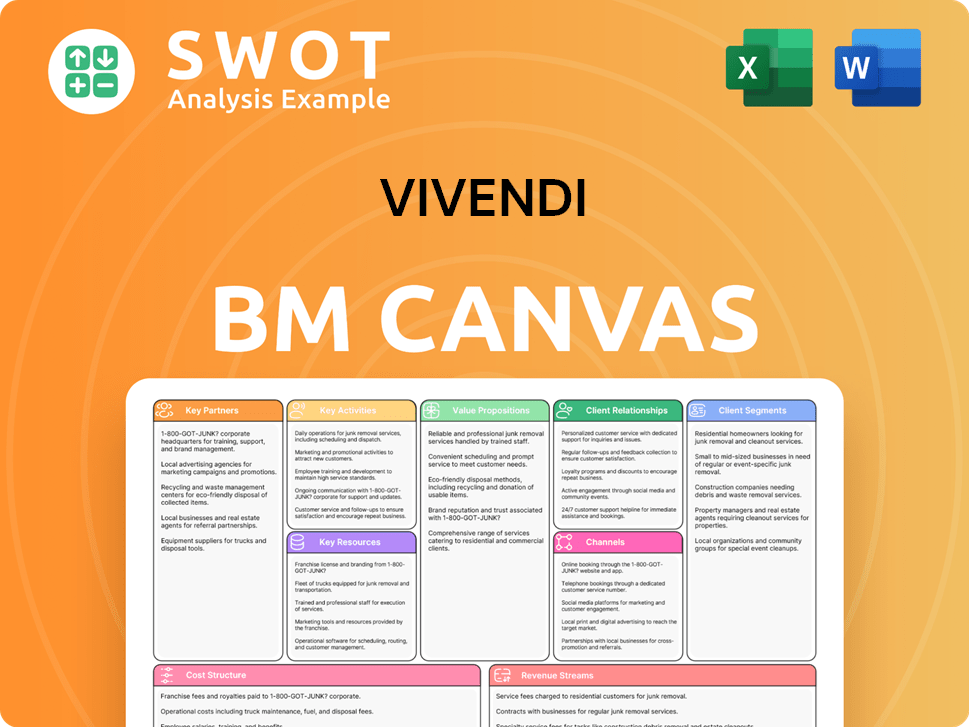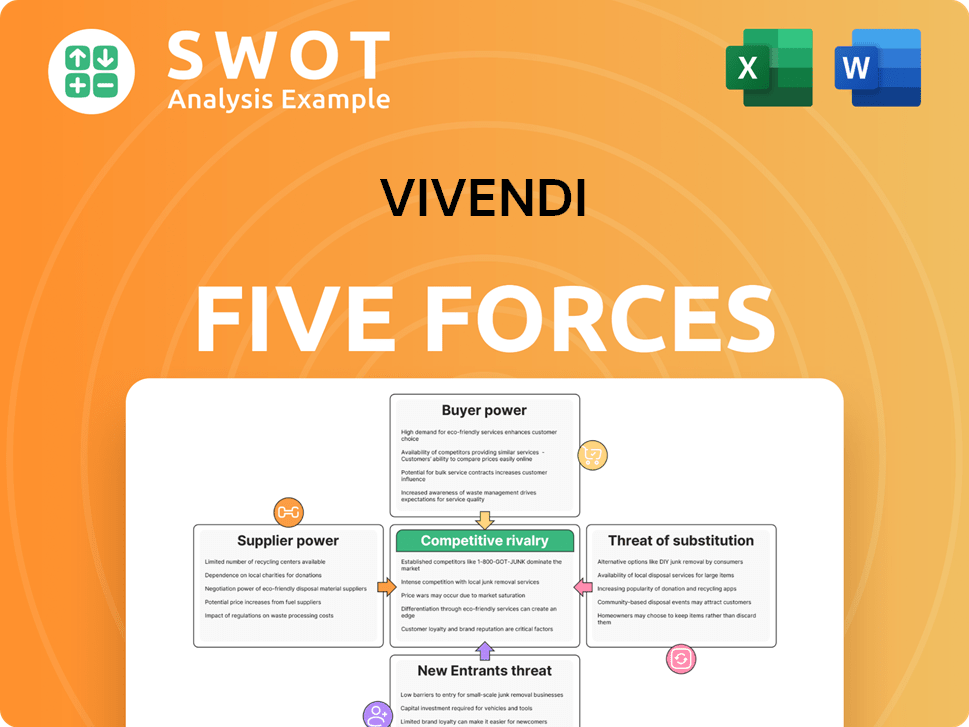Vivendi Bundle
How Does Vivendi Navigate the Cutthroat Media World?
Vivendi, a global media titan, operates in a dynamic landscape shaped by digital disruption and evolving consumer preferences. Understanding the Vivendi SWOT Analysis is crucial for grasping its position amidst fierce competition. This analysis will dissect the company's strategic moves and its response to the ever-changing media environment.

This exploration of Vivendi's competitive landscape will provide a comprehensive market analysis, identifying its key Vivendi competitors and assessing Vivendi's position within the media industry. We'll examine Vivendi's business strategy, including its strengths and weaknesses, and how it combats its media industry rivals. Furthermore, we'll analyze Vivendi's financial performance, market share, and growth strategies in relation to its main competitors, providing insights into its long-term prospects and challenges in the global media market.
Where Does Vivendi’ Stand in the Current Market?
Vivendi holds a significant market position across its diverse media and content segments. The company's operations span television, publishing, communications, and video games, creating a robust and diversified business model. This diversification allows Vivendi to navigate the competitive landscape effectively, leveraging strengths across various sectors to maintain and grow its market share.
The company's value proposition lies in its ability to create, curate, and distribute premium content and services to a global audience. Vivendi focuses on providing high-quality entertainment and information through its various subsidiaries. This approach ensures that Vivendi remains a key player in the media and entertainment industry, adapting to evolving consumer preferences and technological advancements.
Canal+ Group, a key subsidiary, is a leading television provider in France and Africa. As of late 2024, the group reported a subscriber base of 26.4 million, demonstrating its strong reach. Canal+ Group's revenues reached €6.125 billion in 2024, reflecting its robust performance in a competitive broadcasting environment.
Lagardère, acquired by Vivendi in 2023, is a global leader in publishing, particularly in France. Hachette Livre, a part of Lagardère, is the world's third-largest book publisher. This acquisition significantly strengthens Vivendi's presence in the publishing sector, expanding its content offerings and market reach.
Havas, Vivendi’s communications arm, ranks among the largest global communications groups. Havas serves a wide array of clients worldwide, providing comprehensive marketing and communications services. This segment contributes significantly to Vivendi's diversified revenue streams and market presence.
Gameloft, Vivendi's video game subsidiary, maintains a strong presence in the mobile gaming sector. Gameloft's focus on mobile gaming allows Vivendi to tap into a rapidly growing market. This segment enhances Vivendi's ability to attract a younger demographic and diversify its content portfolio.
Vivendi's strategic moves have been pivotal in shaping its Vivendi competitive landscape. The company has strategically shifted its positioning, transitioning from a broad conglomerate to a more focused media and content group. This strategic focus includes a clear emphasis on digital transformation across its segments, adapting to changing consumer preferences and technological advancements. Its geographic presence is notably strong in Europe, especially France, and increasingly in Africa for Canal+. The company serves a broad range of customer segments, from individual consumers of content and games to businesses utilizing its communication and publishing services. Vivendi's financial health remains robust, with its diversified revenue streams providing resilience against market fluctuations. The company's strategic acquisitions, such as Lagardère, further solidify its market standing and expand its reach into new areas. For more details on Vivendi's target audience, you can refer to the Target Market of Vivendi.
Vivendi's market position is supported by several key indicators, including subscriber numbers, revenue figures, and strategic acquisitions. These factors highlight the company's strength and its ability to compete in the media industry.
- Subscriber Base: Canal+ Group's 26.4 million subscribers as of late 2024.
- Revenue: Canal+ Group's 2024 revenues of €6.125 billion.
- Strategic Acquisitions: The acquisition of Lagardère in 2023.
- Global Presence: Strong presence in Europe and Africa.
Vivendi SWOT Analysis
- Complete SWOT Breakdown
- Fully Customizable
- Editable in Excel & Word
- Professional Formatting
- Investor-Ready Format

Who Are the Main Competitors Challenging Vivendi?
Understanding the Vivendi competitive landscape requires a look at its diverse business segments and the rivals they face. The company operates in media and entertainment, which means it competes with a variety of global players. This Vivendi market analysis reveals a complex web of direct and indirect competitors.
Vivendi's position in the media industry is constantly evolving, shaped by mergers, acquisitions, and shifts in consumer behavior. The company's subsidiaries, such as Canal+, Hachette Livre, Havas, and Gameloft, each encounter unique competitive pressures. The media industry is dynamic, and understanding these competitive dynamics is vital for assessing Vivendi's strategic moves.
For more details on the company's financial structure, you can refer to this article: Revenue Streams & Business Model of Vivendi.
Canal+ Group, a key subsidiary, competes directly with major streaming services. These include Netflix, Amazon Prime Video, and Disney+, which have significant content libraries and global distribution networks. Traditional broadcasters and local streaming services also pose competition.
Hachette Livre, a part of Lagardère, faces off against international publishing houses. Key rivals include Penguin Random House (part of Bertelsmann), HarperCollins (part of News Corp), and Simon & Schuster (part of Paramount Global). Competition focuses on author acquisition and digital distribution.
Havas, Vivendi's communications arm, competes with global advertising and marketing groups. These include WPP, Omnicom, Publicis Groupe, and Interpublic Group. These agencies compete based on creativity, client relationships, and integrated service offerings.
Gameloft competes with a broad range of mobile game developers and publishers. This includes large studios such as Tencent and Activision Blizzard, as well as smaller independent developers. Competition in this sector is driven by innovation and user engagement.
The Vivendi business strategy must consider several key competitive factors that affect its subsidiaries. These factors include content acquisition, pricing strategies, technological platforms, and distribution networks. The media industry is highly competitive, with rivals constantly evolving.
- Content Acquisition: Securing exclusive rights to popular content is crucial for attracting subscribers and viewers.
- Pricing Strategies: Competitive pricing models are essential to attract and retain customers in the streaming and publishing sectors.
- Technological Platforms: Investing in advanced technology is vital for delivering content efficiently and enhancing user experience.
- Distribution Networks: Establishing robust distribution networks is key to reaching a global audience.
Vivendi PESTLE Analysis
- Covers All 6 PESTLE Categories
- No Research Needed – Save Hours of Work
- Built by Experts, Trusted by Consultants
- Instant Download, Ready to Use
- 100% Editable, Fully Customizable

What Gives Vivendi a Competitive Edge Over Its Rivals?
Understanding the Vivendi competitive landscape requires a look at its core strengths. Vivendi's position in the media and entertainment industry is shaped by its diverse portfolio and strategic adaptability. The company has consistently adjusted its business model to navigate the dynamic media market.
Key to Vivendi's strategy is its ability to leverage synergies across its various holdings. This includes cross-promotion and the sharing of resources. Vivendi's focus on both traditional and digital distribution channels also helps it maintain a broad reach. The company's strategic moves, such as focusing on digital capabilities, are crucial in today's competitive environment.
Vivendi's competitive edge is further enhanced by its global presence, particularly in emerging markets. Its strong brand equity, stemming from well-known brands, fosters customer loyalty. The company's ongoing investments in technology and content aim to sustain its competitive advantage against media industry rivals.
Vivendi's diverse portfolio includes Canal+, Havas, and Gameloft, among others. This diversification allows for cross-promotion and synergy, creating a robust business model. This strategy helps Vivendi mitigate risks and capitalize on various opportunities within the media sector. The company can leverage its different assets to enhance its overall market position.
The ownership of well-known brands like Canal+ and Havas builds customer loyalty and trust. Brand recognition is a significant asset in the competitive media market. This strong brand equity enables Vivendi to maintain a loyal customer base and attract new audiences. It also allows for premium pricing and increased market share.
Vivendi's international presence, particularly in Africa, provides a competitive advantage. Its global reach helps in accessing diverse markets and audiences. The company's extensive distribution networks support its ability to reach a broad audience worldwide. This global presence is crucial for growth and expansion.
Vivendi's ability to adapt to market demands and simplify its corporate structure is a key advantage. This flexibility allows the company to respond quickly to changes in the media landscape. Strategic agility is crucial for navigating the rapidly evolving digital environment. Vivendi's adaptability helps it stay ahead of its Vivendi competitors.
Vivendi's competitive advantages include a diversified portfolio, strong brand equity, and global reach. These factors enable the company to maintain a strong position in the media and entertainment industry. The company's strategic flexibility and ongoing investments in technology and content are also crucial.
- Diversified Portfolio: Owning brands like Canal+, Havas, and Gameloft.
- Strong Brand Equity: Building customer loyalty and trust.
- Global Reach: Presence in various international markets, including Africa.
- Strategic Flexibility: Adapting to market demands and simplifying its structure.
For more insights into Vivendi's marketing strategies, consider exploring the Marketing Strategy of Vivendi.
Vivendi Business Model Canvas
- Complete 9-Block Business Model Canvas
- Effortlessly Communicate Your Business Strategy
- Investor-Ready BMC Format
- 100% Editable and Customizable
- Clear and Structured Layout

What Industry Trends Are Reshaping Vivendi’s Competitive Landscape?
The media and entertainment industry is undergoing significant changes, with the Vivendi competitive landscape constantly evolving. The rise of streaming services, the importance of data analytics, and regulatory shifts are reshaping the industry. Understanding Vivendi's position and its ability to adapt is crucial for assessing its future prospects.
Vivendi's market analysis reveals both challenges and opportunities. Intense competition from streaming services and the potential impact of regulatory changes pose risks. However, the growth of digital content consumption, particularly in mobile gaming and streaming, offers expansion avenues. Vivendi must leverage its content creation capabilities and explore strategic partnerships to maintain its competitive edge.
The media industry is shifting towards digital content, with streaming services like Netflix and Disney+ dominating. Data analytics and AI are becoming critical for content personalization and targeted advertising. Regulatory changes concerning media ownership and content distribution are also influencing the market.
Intense competition in the streaming market is a major challenge, requiring significant investment in content and subscriber acquisition. Regulatory changes could impact operational flexibility. Declining demand for traditional linear TV and print media poses a threat to some of Vivendi's core businesses.
The global growth of digital content consumption, especially in mobile gaming and streaming, provides avenues for expansion. Strategic partnerships and acquisitions in emerging markets, like Africa, could strengthen Vivendi's position. Investing in AI for content recommendation can enhance user engagement and monetization.
Vivendi aims to become a more digitally-centric and globally integrated media group. The focus is on premium content and diversified revenue streams to remain resilient. Simplifying its corporate structure is intended to unlock value and provide greater agility in responding to market dynamics.
Vivendi's competitors include major media and tech companies. These companies compete in content creation, distribution, and subscriber acquisition. Vivendi's ability to innovate and adapt to changing consumer preferences is vital.
- Content Portfolio: Strong content is crucial. Vivendi's Canal+, Lagardère, and Gameloft provide a diverse range of content.
- Distribution Channels: Effective distribution, including streaming platforms and partnerships, is essential to reach audiences.
- Financial Performance: Vivendi's financial health, compared to media industry rivals, impacts its ability to invest in growth and acquisitions.
- Technological Integration: Utilizing AI and data analytics to enhance content personalization and user engagement.
Analyzing Vivendi's competitive landscape requires understanding its strengths and weaknesses. For example, its ownership structure, as detailed in Owners & Shareholders of Vivendi, influences its strategic decisions. The company's ability to navigate these challenges and seize opportunities will determine its long-term success in the dynamic media industry.
Vivendi Porter's Five Forces Analysis
- Covers All 5 Competitive Forces in Detail
- Structured for Consultants, Students, and Founders
- 100% Editable in Microsoft Word & Excel
- Instant Digital Download – Use Immediately
- Compatible with Mac & PC – Fully Unlocked

Related Blogs
- What are Mission Vision & Core Values of Vivendi Company?
- What is Growth Strategy and Future Prospects of Vivendi Company?
- How Does Vivendi Company Work?
- What is Sales and Marketing Strategy of Vivendi Company?
- What is Brief History of Vivendi Company?
- Who Owns Vivendi Company?
- What is Customer Demographics and Target Market of Vivendi Company?
Disclaimer
All information, articles, and product details provided on this website are for general informational and educational purposes only. We do not claim any ownership over, nor do we intend to infringe upon, any trademarks, copyrights, logos, brand names, or other intellectual property mentioned or depicted on this site. Such intellectual property remains the property of its respective owners, and any references here are made solely for identification or informational purposes, without implying any affiliation, endorsement, or partnership.
We make no representations or warranties, express or implied, regarding the accuracy, completeness, or suitability of any content or products presented. Nothing on this website should be construed as legal, tax, investment, financial, medical, or other professional advice. In addition, no part of this site—including articles or product references—constitutes a solicitation, recommendation, endorsement, advertisement, or offer to buy or sell any securities, franchises, or other financial instruments, particularly in jurisdictions where such activity would be unlawful.
All content is of a general nature and may not address the specific circumstances of any individual or entity. It is not a substitute for professional advice or services. Any actions you take based on the information provided here are strictly at your own risk. You accept full responsibility for any decisions or outcomes arising from your use of this website and agree to release us from any liability in connection with your use of, or reliance upon, the content or products found herein.